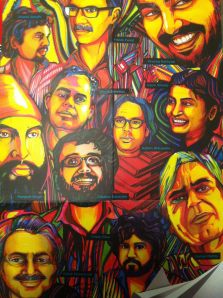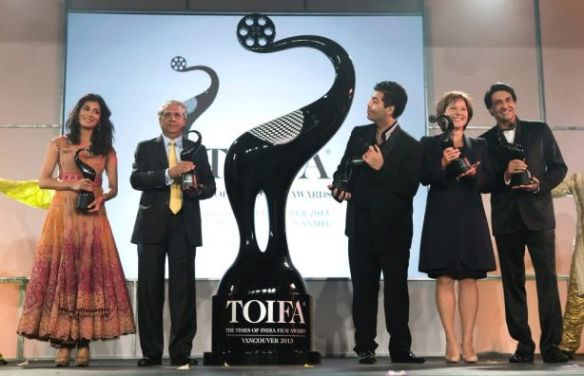Foreword
Through Simon Fraser University’s India Initiative program, supported by the federal government’s Western Economic Diversification office, my colleague Sara Blake and I spent ten weeks in India exploring the potential for Indian-Canadian partnerships in the film industry in 2012. We were asked to research the current state of filmmaking in India and report on opportunities for collaboration with Canadian producers. We found many filmmakers, educators and production executives were very interested in telling us about the current state of the Indian film industry and wanted to know more about coproduction, but the truth is that there is so much interest in India that until now, there has been almost no awareness of BC film and the coproduction possibilities that are ripe for production.
India already has co-production treaties with the United Kingdom, France, Germany, Italy, Spain, New Zealand, and Brazil. Considering our significant South Asian population and the success of Indo-Canadian filmmakers such as Deepa Mehta, Richie Mehta, and Vic Sarin, one would expect that Canada should be next on the list. Canada and India have been negotiating a treaty on and off for about ten years and people are hopeful that an agreement will soon be reached. The issue that seems to stand in the way is that coproduction has many incentives for Indian producers, but very little incentive for foreign industries apart from the value of the Indian Rupee. The low number of films that have been made under the negotiated coproduction treaties illustrates this, and this is an issue that needs to be looked into further.
However, even without a treaty we could see that increasing the connections between BC and India with information transfer and expertise through labor and talent exchanges in animation and production technologies can benefit both parties. In order to accomplish this we need to increase our understanding of the industry in India, become aware of productions and events, and build up a professional network.
The Research
From May to August we conducted one-on-one interviews with a number of industry professionals, including major producer/directors such as Anurag Kashyap (Dev D.) and Ketan Mehta (The Rising: Ballad of Mangal Pandey). We prepared for the trip in Vancouver by interviewing filmmakers and producers who had already worked on various India-related projects. Through interviews with Richard Brownsey (BC Film + Media), Jack Silberman (filmmaker) and Brigitte Monneau (Telefilm), we learned about the status of Canadian co-productions and ongoing negotiations with India’s Ministry of Information and Broadcasting.
However, most of the Vancouver producers we met had been working on documentaries, so the information we gleaned was about the least practiced form of Indian cinema. Nimisha Mukerji, Meghna Haldar, and Jayanti Ram explained how difficult it can be to work with Indian crews who are untrained in documentary-style shooting as well as some of the issues resulting from cultural differences and dealing with local authorities.
Chennai
Our first stop was Chennai for the IIT Madras Imaging Cinema workshop, which attracted participants from around the country. We interned with Dr. Aysha Iqbal, director of the ten-day workshop, and made vital connections with experts from both the Tamil and Hindi film industries. Among the many important and high-profile guests, the meetings that were most integral to our research were with screenwriting/directing brothers Shridhar and Sriram Raghavan and cinematographer Ravi K. Chandran. They gave us a good idea of how storytelling has evolved in Indian cinema, and an overall impression of attitudes toward filmmaking as a profession and a career. Talking with other filmmakers such as Sudhish Kamath and watching panel discussions at the workshop, we gained a deeper understanding of the different styles of India cinema, encompassing regional and independent film as well as Bollywood. During the workshop we also made connections with many young filmmakers and film students and many film enthusiasts who opened our eyes to the interests and the demands of Indian audiences.
Mumbai
On our first day in Mumbai, Ravi K. Chandran invited us to Film City, the major studio complex at the north end of the city, to watch a commercial shoot where he was working as director of photography. As in Canada, crews can take on many shapes and sizes depending on the budget and scope of the production. The reasons for the variety in production standards in India as well as variation in hierarchy systems were explained to us by cinematographers Manoj Lobo and Deepti Gupta. They also informed us of the status of women in industry production roles. We are now familiar with some of the difficulties that a Canadian filmmaker could face when trying to work with Indian crews. However, we were made aware of the importance for sensitivity and compromise foreign filmmakers need to practice if they want to be successful.
We reconnected with the Raghavan brothers and Rohan Sippy (Chandni Chowk to China), producer-director of several feature films in international release; they generously compiled a list of over twenty industry professionals that we could contact and interview with their referral. We interviewed a corporate producer, Purva Naresh from Reliance Entertainment; a private studio producer, Swati Shetty, who had recently left Banerji Studios to start her own company; and one of the most respected and successful of Indian New wave filmmakers, writer/ producer/director Anurag Kayshyap (Dev D). These interviews revealed the great diversity in the industry as well as the many contrasting opinions of Indian cinema and what it takes to produce a film in India. More details on specific companies and filmmakers are provided in our longer report.
Regional Cinema
Pune, within commuting distance of the capitol of Hindi cinema in Mumbai, is the base of the far less visible Marathi-language cinema, which struggles for recognition outside its own linguistic circle. An enlightening interview with Girish Kulkarni (Pune 52) illustrated the many strategies he and his co-producer, Umesh Kulkarni, have employed to produce their films for a small market, the difficulties that face independent filmmakers, and the bias marketers and distributors have toward regional cinema. Another interview with Kranti Kanade informed us of how film associations such as the National Film Development Corporation and the Children’s Film Society have enabled emerging filmmakers to create; he also explained how he has managed to outsource production to the United States for his unreleased film Gandhi of the Month.
In Hyderabad we investigated the Telugu-language film industry. We had excellent meetings with Jayanth Paranjee and Dagubatti Suresh Babu to elaborate on the industry differences between the Northern and Southern cinema, as well as some exposure to Telugu films and the single screen cinema experience. We also met with Mohan Krishna, a Hyderabadi director who did his schooling at York University and then managed to break into the Telugu film industry after years of hard work and dedication.
Animation
Animation is a growing sector, particularly in Hyderabad and Mumbai. We met with major Bollywood producer/director Ketan Mehta (The Rising: Ballad of Mangal Pandey), who has diversified from the feature film industry with the first feature-length animated version of the Indian epic Ramayana. Until very recently, animation has not been taken seriously by producers for anything other than children’s stories. However, a film starring a reincarnated fly that seeks revenge on the man who murdered him and took his wife seems to be changing this. The film Eega (Suresh Productions) was a huge success in the Telugu language and has recently been released in Hindi. The adult themes explored in this film, combined with its commercial success, have opened the doors to animation as a viable medium for storytelling. The animation industry is one that bears further study, particularly because of Canada’s expertise and coproduction possibilities in the area.
A New Initiative
Back in Canada, I attended the Toronto International Film Festival and reconnected with several filmmakers we had met in India, including Anurag Kashyap, Anand Gandhi, and Hansal Mehta. Another Indo-Canadian connection made at TIFF was Vipin Sharma, an actor who worked in Toronto for many years and recently transplanted his career to Mumbai. The TIFF experience was a great way to strengthen our earlier connections and build new ones. The timing for our project is excellent, as awareness of independent Indian cinema is increasing in Canada with the upcoming Times of India Film Awards in April, and the recent focus on Indian cinema at film festivals around the world. It is an appropriate time for Indian cinema to expand its audience, as this year marks the Centennial of the Indian film industry.
The Future
This summary only scratches the surface of what we learned about the Indian film industry. The future of Indian coproduction is not more Bollywood films shot in the Rocky Mountains or a way for Canadian productions to outsource labor to India. Co-production can function commercially as a way of expanding Indian cinema’s audience and tell transnational stories; these will include new stories that reflect the globalized world we live in today and increase Indian awareness of Canada and Canadian cinema. Animation is an area in which Canada excels both technically and creatively; Indian filmmakers may benefit from being exposed to Western animation production methods. Increasing the production of Indian stories told through the animation medium, as well as a transfer of best practices, will help increase the visual quality of Indian animated films.
Now I am back in Mumbai to continue working on this initiative to increase collaboration between Indian and Canadian film. At this time, the British Columbia film industry is in a state of crisis due to an overdependence on Hollywood to outsource its production to Vancouver for tax credits. Vancouver is the third largest film production center in North America, and has an incredible workforce, film-friendly infrastructure, and some of the most beautiful scenery in the world but because of tax-credit bidding war between Vancouver, Toronto, and Quebec, the industry is in crisis because despite the millions of dollars being provided by the government, employment in BC film continues to drop. There is much debate as to what is the true solution to the problem, but I think the first step for BC film is to diversify itself as a site for not only American productions but to encourage Indian productions. Vancouver is an international city and full of new emigrants with international stories to tell. A coproduction treaty with India will make it easier to tell these stories and give the BC film industry the films and the international audience it needs to become self-sufficent.
Co-productions will create environments for a blending of storytelling sensibilities and new international audiences. In smaller-market areas like independent, regional, and new wave cinema, co-production will be an effective way to increase budgets, production quality, and distribution, and enhance the commercial viability of these sectors. This new initiative also has the ability to increase international awareness of Canadian cinema and filmmakers by expanding its Indian audience. Through international collaboration, we see new grammars of filmmaking being forged, and new audiences being made.
If you would like to contribute to the immediate future of BC Film, you can sign the SAVE BC FILM petition.
To come: Future blog entries on the different facets of the Indian Film industry from our research FYI.





Pingback: Mounties in Mumbai | Paula McGlynn
Pingback: BC Film, Tourism, and India Post-TOIFA | Paula McGlynn
Pingback: BC Film, Tourism, and India Post-TOIFA | BC-India Film and Media
Pingback: Mounties in Mumbai | BC-India Film and Media
Pingback: The India Initiative and Solutions for the BC Film Industry | BC-India Film and Media